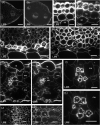Mapping Pectic-Polysaccharide Epitopes in Cell Walls of Forage Chicory (Cichorium intybus) Leaves
- PMID: 34880888
- PMCID: PMC8646105
- DOI: 10.3389/fpls.2021.762121
Mapping Pectic-Polysaccharide Epitopes in Cell Walls of Forage Chicory (Cichorium intybus) Leaves
Abstract
The cell walls of forage chicory (Cichorium intybus) leaves are known to contain high proportions of pectic polysaccharides. However, little is known about the distribution of pectic polysaacharides among walls of different cell types/tissues and within walls. In this study, immunolabelling with four monoclonal antibodies was used to map the distribution of pectic polysaccharides in the cell walls of the laminae and midribs of these leaves. The antibodies JIM5 and JIM7 are specific for partially methyl-esterified homogalacturonans; LM5 and LM6 are specific for (1→4)-β-galactan and (1→5)-α-arabinan side chains, respectively, of rhamnogalacturonan I. All four antibodies labelled the walls of the epidermal cells with different intensities. JIM5 and JIM7, but not LM5 or LM6, labelled the middle lamella, tricellular junctions, and the corners of intercellular spaces of ground, xylem and phloem parenchyma. LM5, but not LM6, strongly labelled the walls of the few sclerenchyma fibres in the phloem of the midrib and lamina vascular bundles. The LM5 epitope was absent from some phloem parenchyma cells. LM6, but not LM5, strongly labelled the walls of the stomatal guard cells. The differential distribution of pectic epitopes among walls of different cell types and within walls may reflect the deposition and modification of these polysaccharides which are involved in cell wall properties and cell development.
Keywords: arabinan; chicory; galactan; homogalacturonan; immunolabelling; pectins.
Copyright © 2021 Sun, Andrew, Harris, Hoskin, Joblin and He.
Conflict of interest statement
The authors declare that the research was conducted in the absence of any commercial or financial relationships that could be construed as a potential conflict of interest.
Figures







Similar articles
-
Distribution of pectic epitopes in cell walls of the sugar beet root.Planta. 2005 Oct;222(2):355-71. doi: 10.1007/s00425-005-1535-3. Epub 2005 May 11. Planta. 2005. PMID: 15887026
-
Localization of cell wall polysaccharides in nonarticulated laticifers of Asclepias speciosa Torr.Protoplasma. 2001;216(3-4):215-26. doi: 10.1007/BF02673873. Protoplasma. 2001. PMID: 11732189
-
Developmental changes in guard cell wall structure and pectin composition in the moss Funaria: implications for function and evolution of stomata.Ann Bot. 2014 Oct;114(5):1001-10. doi: 10.1093/aob/mcu165. Epub 2014 Aug 16. Ann Bot. 2014. PMID: 25129633 Free PMC article.
-
Immunolocalization of pectic polysaccharides during abscission in pea seeds (Pisum sativum L.) and in abscission less def pea mutant seeds.BMC Res Notes. 2016 Aug 31;9(1):427. doi: 10.1186/s13104-016-2231-z. BMC Res Notes. 2016. PMID: 27581466 Free PMC article.
-
Detection of Pectic Polysaccharides in Abscission Zones by Immunolocalization.Methods Mol Biol. 2025;2916:55-59. doi: 10.1007/978-1-0716-4470-6_5. Methods Mol Biol. 2025. PMID: 40366585
Cited by
-
Immunocytochemical Analysis of the Wall Ingrowths in the Digestive Gland Transfer Cells in Aldrovanda vesiculosa L. (Droseraceae).Cells. 2022 Jul 16;11(14):2218. doi: 10.3390/cells11142218. Cells. 2022. PMID: 35883661 Free PMC article.
-
Immunocytochemical Analysis of Bifid Trichomes in Aldrovanda vesiculosa L. Traps.Int J Mol Sci. 2023 Feb 8;24(4):3358. doi: 10.3390/ijms24043358. Int J Mol Sci. 2023. PMID: 36834769 Free PMC article.
-
Immunohistochemical dynamics of cell wall matrix polymers during tomato autograft healing.Plant Mol Biol. 2023 Dec;113(6):353-365. doi: 10.1007/s11103-023-01351-7. Epub 2023 Apr 20. Plant Mol Biol. 2023. PMID: 37079121 Free PMC article.
-
Compartmentalization of epidermal mucilage cells by new cell wall formation in Myrsine umbellata Mart. (Primulaceae).Protoplasma. 2025 Jun 4. doi: 10.1007/s00709-025-02080-y. Online ahead of print. Protoplasma. 2025. PMID: 40468030
References
-
- Andeme-Onzighi C., Girault R., His I., Morvan C., Driouich A. (2000). Immunocytochemical characterization of early-developing flax fiber cell walls. Protoplasma 213 235–245. 10.1007/bf01282161 - DOI
-
- Barry T. N. (1998). The feeding value of chicory (Cichorium intybus) for ruminant livestock. J. Agric. Sci. 131 251–257.
LinkOut - more resources
Full Text Sources

